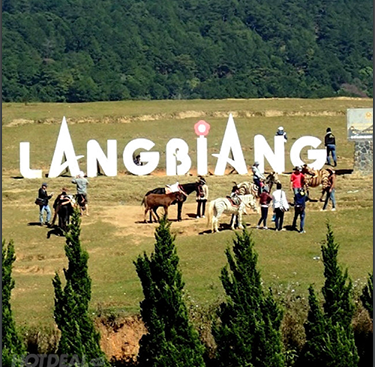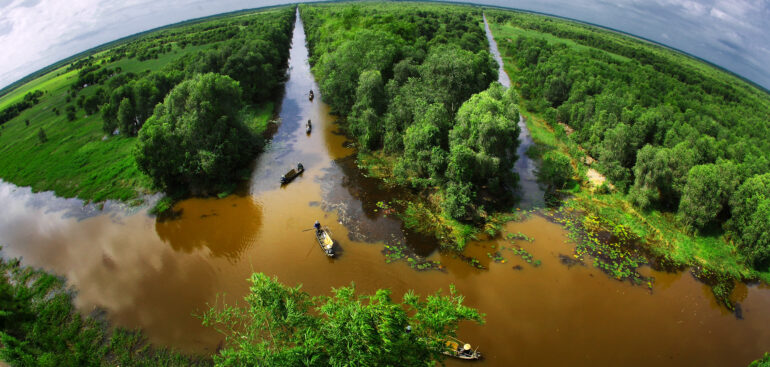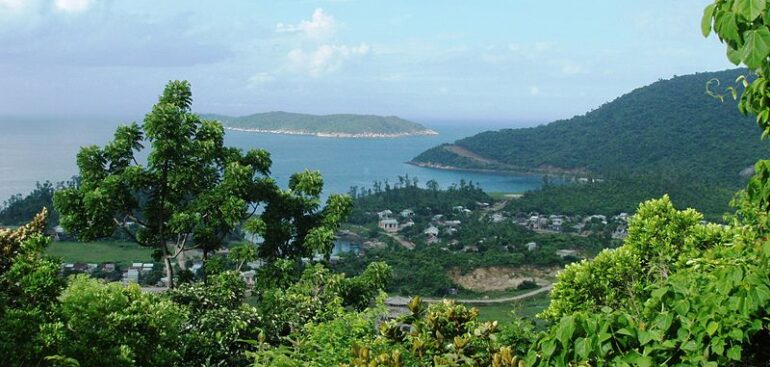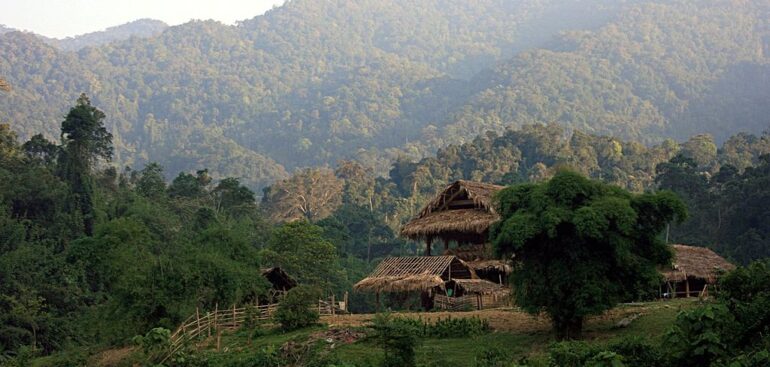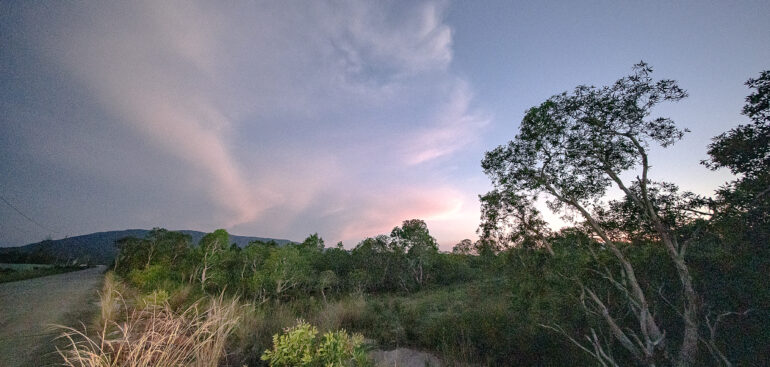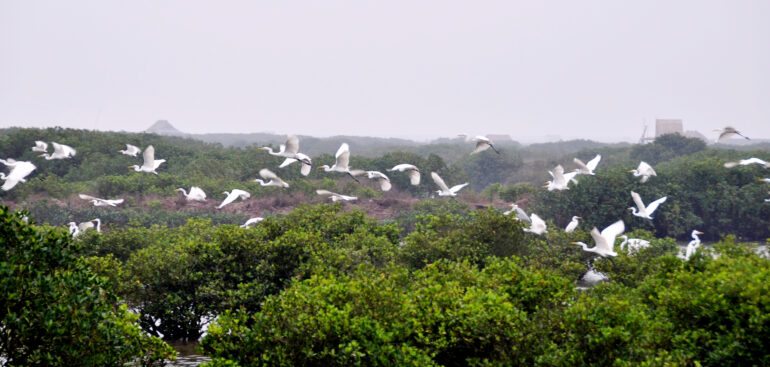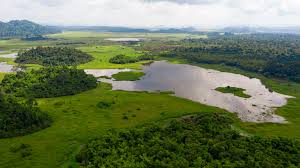The conservation areas have international status
Biosphere Reserves
1. Introduction
The concept of biosphere reserves was introduced in the 1970s by the United Nations Educational, Scientific and Cultural Organization (UNESCO) and has developed strongly since 1995 when people recognized the method of preserving Traditional conservation through strict conservation in nature reserves is difficult to achieve the desired effect, especially in densely populated areas with limited resources, where conflicts between conservation and development often occur. In 1976, the world network of Biosphere Reserves was formed and by 2019 there were 686 Biosphere Reserves worldwide in 122 countries and territories.
World Biosphere Reserves are recognized within the framework of the UNESCO “Man and the Biosphere Program” (MAB) and are defined as areas of coastal or terrestrial ecosystems that promote solutions to harmonize the conservation of human resources. Preserving biodiversity with sustainable development of that area has outstanding value and is internationally recognized. In terms of methodology, the Biosphere Reserve considers “Humans are part of the biosphere” and are “Ecological Citizens”. The establishment of World Biosphere Reserves is aimed at creating demonstration models that demonstrate the harmonious relationship between humans and nature, balancing the needs of today’s people with future generations and nature (German Commission for UNESCO, 2015).

Xuan Thuy National Park (belongs to the Red River Biosphere Reserve) – Photo provided by the National Park
The Biosphere Reserve is a unique model with the motto of harmonizing conservation and development by ensuring the implementation of 3 functions associated with 3 partitions (Core zone, Buffer zone, Transition zone): including i) conservation Biodiversity, ii) environmentally friendly economic development, and iii) support for research, education and training with the participation of all parties: departments, private economy, research, civil society events, local people. In other words, the goal of harmonizing development and conservation can be achieved by drawing on two ideas at the heart of the Biosphere Reserve concept: engagement with local communities (participation, co-management) and Use knowledge-based methods (traditional knowledge, scientific research, monitoring and education). UNESCO’s recognition of an area as a Biosphere Reserve can raise awareness of local people, the public and authorities at all levels about environmental and development issues. The Biosphere Reserve model is different from conventional conservation models in that it is not a type of regulation, does not create a rigid form of management, and is not a world heritage site or a conservation area. closed”, and it does not limit the rights of local people or immigrants (UNESCO/MAB, 2016).
Lima Action Plan on World Biosphere Reserves 2016-2025: MAB/UNESCO has developed the Seville Strategy and the Statutory Framework of the World Biosphere Reserve (WNBR) as well as implemented the Action Plan (KHHD) Madrid on Biosphere Reserve (2008-2013). Inheriting and based on the results of evaluating the implementation of the Madrid Action Plan, 2016 in Peru, UNESCO adopted the MAB Strategy for the period 2015-2025 and announced the LIMA Action Plan 2016-2025, this is considered a General direction and operational orientation for the entire network of Biosphere Reserves in the world. The main goal of this Plan is to ensure the maintenance and development of the Biosphere Reserve Network into effective models of sustainable development at the local level; Focus on building prosperous communities in harmony with the biosphere to contribute to achieving the United Nations Sustainable Development Goals (SDGs) by 2030.

Figure 1. Areas and functions of the Biosphere Reserve
2. Management model of some Biosphere Reserves in the world
UNESCO has proposed mechanisms for management and conservation including: (i) mechanisms to manage human activities and exploitation in the buffer zone; (ii) have a policy or management plan for the entire Biosphere Reserve; (iii) develop a regulation or team of management staff to implement that policy or plan; (iv) have research, monitoring, education and training programs (UNESCO, 1995). Countries do not need to promulgate special laws for Biosphere Reserves, but should take advantage of or integrate into the existing legal framework on conservation, management of natural resources (land, water,…) and the environment, and at the same time, have can build its own operating system with the participation of relevant parties. And to monitor and measure the results of that process, biosphere reserves must periodically evaluate management effectiveness every 10 years.
When conducting a 10-year assessment, some Biosphere Reserves such as Mananara-Nord, Sumava (Czech Republic), Aggtelek (Hungary) or Babia Gora (Poland) pointed out common shortcomings that limit the management effectiveness of the Biosphere Reserve. is the unclear position of this model in the national and regional legal system and the lack of sustainable financial resources for management and coordination agencies. On the other hand, Noosa Biosphere Reserve (Australia) builds a management model based on target groups and activities, such as environment, society, culture, tourism, education, and economy (MAB, Australia, 2009) in At that time, Kogelberd Biosphere Reserve in South Africa (2012) integrated the socio-economic system and ecosystem into a new system: Social-ecological system and spatial planning for conservation and development. for effective QSQ management. These operating methods have achieved certain successes when connecting regions and related parties towards common development goals. Thus, biosphere reserves can develop their own management systems, suitable to the national context and institutions and to ensure their functions and goals.
Environmental and development issues in the context of biosphere reserve coordination are subject to different levels of governance (Von Moltke, 2006). Young (2002) uses the term ‘horizontal interaction’ when referring to spatial aspects of biodiversity governance. Vertical interactions are interactions between organizations on scales from international to local levels and Horizontal interactions are inter-organizational links across sectors at one of these levels. Just like community-based biodiversity conservation, coordination and cooperation in the Biosphere Reserve depends not only on local actors – with their existing rules and regulations – but also on existing frameworks. strategic, institutional, legislative framework: This is governance that starts at the grassroots level and involves linkages across different organizational levels (Berkes, 2007).
For the Sumava Biosphere Reserve (Czech Republic), at the national level, the legal and administrative framework is consistently applied for ecosystem management, however the Biosphere Reserve is not mentioned in the National Nature Conservation Law and other regulations. type of protected area (Schliep et al., 2010). There is no central coordinating body for the Biosphere Reserve, but cooperation in efforts related to the Biosphere Reserve is expressed in annual meetings between the MAB committee and representatives from the agencies responsible for managing the Biosphere Reserve in the area. local level. At the local level, the biggest pressure is the hot development of tourism, which directly impacts and reduces both agriculture and forestry, increasing income but causing great environmental degradation. The problem is that the parties have difficulty working together to solve common problems occurring in Biosphere Reserve and the lack of close interaction between local authorities, the National Park Management Board and residential communities. Some of the reasons given are the lack of a separate management agency to coordinate the overall Biosphere Reserve, the lack of a communication strategy for stakeholders and the lack of effective support from the National MAB Committee. Similar is the case of Hungary’s Aggtelek Biosphere Reserve with the Management Board represented by the Aggtelek National Park Board of Directors, an independent legal body under the supervision of the Ministry of Environment and Water. The National Park’s budget is provided by the Ministry of Environment and Water but is very limited. The MAB National Committee has accordingly become less active, implementation at the local level is also limited by a lack of both budget and qualified staff. power, lack of participation of stakeholders in decision making. In short, the biggest difficulty of Aggtelek KSTQ as well as Sumava (Czech Republic) is that there is no separate coordinating agency for KDTSQQ and therefore it is very difficult to connect the parties.
Babia Gora Biosphere Reserve of Poland (and part of the Slovak Republic) has its own management direction, making the most of existing policies such as Poland’s nature conservation policy, integrating biodiversity into activities. cross-sectoral dynamics (OECD, 2003). Within the existing legal framework, legal regulations related to protected areas have been applied to the management of the Biosphere Reserve. Each part of the Biosphere Reserve area is protected as a national park, landscape park or nature reserve. All areas used by people within the National Park or Nature Reserve must comply with the management regulations of the National Park and Nature Reserve. However, in recent years, as tourism has developed strongly, conflicts have arisen between the parties, especially with the people, as there have been no commitments or documents showing cooperation or sharing of benefits. Pressures from “rural urbanization” and agricultural land use conversion further challenge conservation work. One of the main reasons given is the lack of participation of regional and local authorities in the management and coordination of the Biosphere Reserve.
The French MAB program since the early 2000s has developed a guidance document to develop a management plan for Biosphere Reserve that focuses on methods and tools in land use planning, and provides steps to manage core zones, buffer zones and transition zones, and propose common activities for all zones such as education and research (Bioret et al., 1998). However, the management plan does not indicate a specific legal framework for biosphere reserve management, but recommendations should be based on the national context. Noosa Biosphere Reserve (Australia) builds a management model according to target groups and activities, such as environment, society, culture, tourism, education, and economy (MAB (Australia), 2009) while Kogelberd Biosphere Reserve in South Africa (Kogelberd Biosphere Reserve Company, 2012) integrates the socio-economic system and ecosystem into a new system, the Social-Ecological System, through the development of spatial planning for conservation and growth to effectively manage biosphere reserve. Although the study does not clearly state the management framework of these Biosphere Reserves, it shows that the outstanding advantage is applying systems thinking to the entire system, connecting 3 regions according to the chain of quality economic products and therefore has a connection. connection between the community, the government and the Biosphere Reserve management unit.
Jeju Island Biosphere Reserve (Korea) and Shang Kou (China) are also examples of effective management models with good experiences in building collaborative governance models and creating strong relationships. close, sustainable partnership. Jeju Island Biosphere Reserve has a separate Management Board headed by the highest provincial leader and affiliated with part-time members. Management contents are integrated into local economic development and natural resources conservation activities. All land disputes, pollution reduction, branding of specific products (such as “Biosphere Tangerine”), “ancient Korean village” heritage, etc.) are all resolved harmoniously on the basis of cooperation. between stakeholders and transparency about benefit sharing. Eco-cultural tourism has developed very quickly and brought benefits to the community as well as all parties, and financial resources to support conservation have been improved. Similarly, Shang Kou Biosphere Reserve (China), which is also a National Park and a Ramsar site, has made the most of its titles to attract investment and assistance from international organizations. Obviously, the cooperative governance model, the mechanism for transparency of benefits and the role of leaders with enough necessary power will increase participation and strongly promote the role of Biosphere Reserve.
3. Biosphere Reserves in Vietnam
In Vietnam, the National Committee for Man and the Biosphere Program (MAB Vietnam) is the national focal point of UNESCO in Vietnam established in 1985, with the purpose of building and proposing Biosphere Reserves. for international recognition, management support and maintenance of national and international connections in this field.
Up to now, Vietnam has 11 Biosphere Reserves recognized by the World Man and Biosphere Program (MAB-UNESCO), in both delta, mountainous, coastal and island areas, including: Biosphere Reserve of mangrove forests Can Gio saltwater reserve (2000), Cat Ba Archipelago Biosphere Reserve (2004), Red River Delta Biosphere Reserve (2004), Kien Giang Coastal and Island Biosphere Reserve (2006), Western Nghe An Biosphere Reserve (2007), Cape Ca Mau Biosphere Reserve (2009), Cu Lao Cham – Hoi An Biosphere Reserve (2009), Dong Nai Biosphere Reserve (2011), Lang Biang Biosphere Reserve (2015), Nui Chua Biosphere Reserve (2021), Kon Ha Nung Biosphere Reserve (2021). Compared to the 9 countries with biosphere reserves in Southeast Asia, Vietnam (11 zones) is second only to Indonesia in terms of quantity.
The total area of 09 Biosphere Reserves (recognized in the period from 2000 – 2015) of Vietnam is more than 4 million hectares, accounting for about 12.1% of the natural area of the country, this is also the habitat of about 1.78 million people (Vo Thanh Son, et al., (2018). The core area alone (mainly national parks, protected areas and special-use forests) accounts for 11% of the total area of the Biosphere Reserve (about 450,000 hectares) , this place has a high concentration of biodiversity with a wealth of ecosystem services. The smallest biosphere reserve is Cat Ba Island with 26,241 hectares and the largest is Tay Nghe An with more than 1.3 million hectares Mainly, Biosphere Reserves in Vietnam can be divided into 3 groups: Group 1 is characterized by belonging to a province/city and located within a locality (district/city of the province) and has 1-2 core areas (including Can Tho). Now, Cat Ba Islands and Cu Lao Cham-Hoi An); 2) Group 2 is characterized by belonging to 1 province/city and located in many districts of the province, with 1-3 core areas (LangBiang, Mui Ca Mau, Kien Giang and Tay Nghe An); Group 3 is the areas under many provinces, located in many districts of the provinces and has 2 core regions (Red River Delta and Dong Nai).
Biosphere reserves in Vietnam contain extremely unique biodiversity values and contribute to local development, including: island ecosystems (Cat Ba), coastal and marine mangrove ecosystems (Song Hong, Cu Lao Cham – Hoi An, Can Gio, Kien Giang, Cape Ca Mau), monsoon tropical forest ecosystem (Western Nghe An), tropical forest ecosystem (Lang Biang), mainland forest ecosystem and inland wetlands ( Dong Nai).
Biosphere reserve in Vietnam is managed by many different agencies. While the core zone (National Park, Nature Reserve) is directly managed vertically by specialized ministries (Ministry of Agriculture and Rural Development, Ministry of Natural Resources and Environment…), the buffer zone and transition zone are managed by localities. Therefore, to organize and coordinate activities of relevant departments, branches, local authorities and communities, the Biosphere Reserves have established Management Boards and support departments (collectively referred to as Management Boards). . For Biosphere Reserves located within the boundaries of a province, the decision to establish a Management Board is approved by the Provincial People’s Committee. In cases where the Biosphere Reserve is located within the boundaries of many provinces such as the Biosphere Reserve of the Red River Delta, the decision to establish a Management Board is issued by the UNESCO Vietnam National Committee.
The Management Board performs the task of advising and assisting the Provincial/City People’s Committee in managing Biosphere Reserve in accordance with the provisions of Vietnamese law and according to the professional guidance of the Vietnam UNESCO Committee and the Vietnam MAB Committee. Biosphere reserves often have the following structure: (1) Management board; (2) Secretariat or Department; (3) Advisory Council. Specifically:
Management Board: Regarding organizational structure, the Management Board is headed by a provincial/city leader, with members being leaders of departments, branches, branches, People’s Committees of districts under the Biosphere Reserve and other relevant parties. . Depending on the specific conditions of each Biosphere Reserve, some members of the Management Board who are representatives of other local stakeholders also participate such as: scientists or research institutes (Cat Ba and Mui Ca Mau), businesses or business associations in Dong Nai and Mui Ca Mau), mass organizations (Dong Nai). As for the Western Nghe An Biosphere Reserve, there are no representatives of other organizations in the Management Board. The Dong Nai Biosphere Reserve Management Board does not have any representatives from the People’s Committee and the departments and branches of the provinces related to the Biosphere Reserve. Another characteristic is that all members work on a part-time basis. In terms of function, the Biosphere Reserve Management Board usually does not directly manage the territory but is based on the provisions of Vietnamese law and the provisions of international conventions to organize and coordinate activities. Currently, the management of Biosphere Reserves is based on cooperation between the National Committee for Man and the Biosphere Program (MAB Vietnam) and the Management Board of Biosphere Reserves.
The number of officials directly working related to the management of the Biosphere Reserve ranges from 5 – 20 people in the form of a Secretariat, including officials and leaders representing many departments, branches, branches and government levels ( commune, district, province) in which key staff are often taken from the National Park/NR – core area. However, the majority of staff are part-time and combined, with a very small number of full-time staff (2-3 people). The Secretariat’s concentration and working efficiency are not high, mainly relying on the flexibility and positivity of a few core personnel. Regular budget sources for the activities of the Management Board are limited, lacking funds for capacity building, especially management capacity and updating information, new knowledge, and foreign languages (Van Cuong, C., et al.,2020). The management or management effectiveness of the Biosphere Reserve is essentially the work and level of mobilization and integration of resources in general and human resources in particular from different units and levels of government. Besides, the staff capacity of the Management Board is also an issue that needs to be improved, most of them are trained in one discipline (from forest rangers, irrigation, etc.), lack interdisciplinary knowledge and lack coordination experience. multi-sectoral cooperation, lack of skills in strategic management planning as well as monitoring, supervision and system integration. This is a long-standing difficulty in most Biosphere Reserves.
Regarding organizational structure, the Biosphere Reserve Management Boards currently do not have a unified organizational model. Each locality forms an organizational structure for managing Biosphere Reserve depending on its approach. Meanwhile, unifying the management model is an important condition for unifying State management. Our country’s Biosphere Reserve system does not have specific guidance from the central level to help the Zones perfect their organizational apparatus and operating regulations, which leads to many Biosphere Reserves having difficulty in perfecting their organizational and management apparatus. coordinate activities (HTN Ha, 2018). After 15 years of establishment, the Red River Delta Biosphere Reserve has built a coordination mechanism for management and conservation with the consensus of all three provinces (Ninh Binh, Thai Binh, Nam Dinh). After 6 years of receiving the title of Biosphere Reserve in Western Nghe An, a Management Board was established and after 7 years, management regulations were issued. In 2018, a new, more appropriate management regulation was developed. Ca Mau Cape also only has management regulations after 5 years of establishment.
In addition, many Biosphere Reserves are under the administrative management of many districts, towns or provinces, and have large areas and populations, so the management of Biosphere Reserves faces many challenges. Typically, Dong Nai Biosphere Reserve is located within the administrative boundaries of 5 provinces and 20 districts, cities and towns. However, the Management Board only includes State components, representatives of social organizations and businesses of Dong Nai province, so the activities of Biosphere Reserve in the remaining 4 provinces are not strong, and even few activities are carried out. currently under the name of KDTSQ.
Stakeholders participating directly or indirectly in the management of Biosphere Reserve in Vietnam include 4 main groups but are not complete: i) State agencies, including: i) ministries, branches and central-level agencies: UNESCO Vietnam, MAB Vietnam, Ministry of Agriculture and Rural Development, Ministry of Natural Resources and Environment, Ministry of Science and Technology, Ministry of Foreign Affairs; ii) local level: Biosphere Reserve Management Board, relevant departments and branches (Natural Resources and Environment, Agriculture and Rural Development, Culture, Sports and Tourism, etc.), Management Boards of conservation areas/national parks, People’s Committees of districts, communes/wards/towns; ii) Local community: includes representatives of communes in 3 functional zones, mass organizations (such as the Women’s Union, Farmers’ Union, forest protection groups – community representatives; iii) Organizations research, training and development: international UNESCO, domestic and foreign organizations/projects, experts, research staff of institutes, universities and non-governmental organizations (NGOs); and iv) Local businesses (tourism, agriculture, construction, …).




